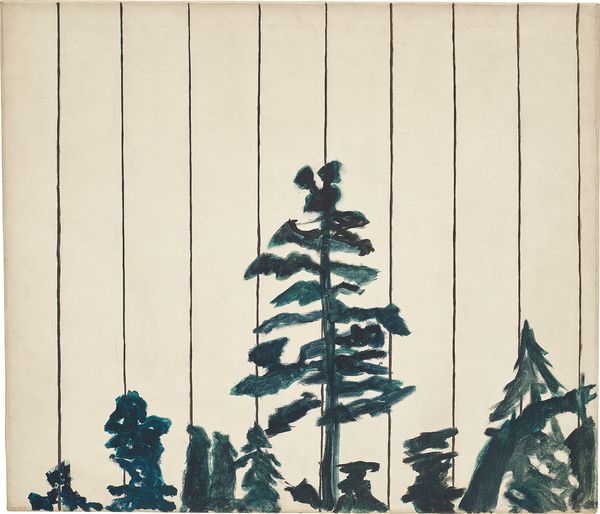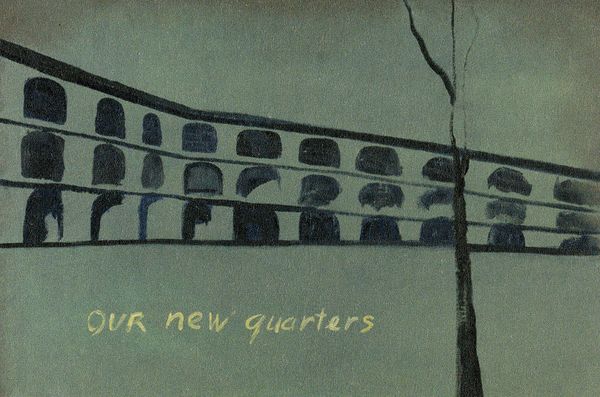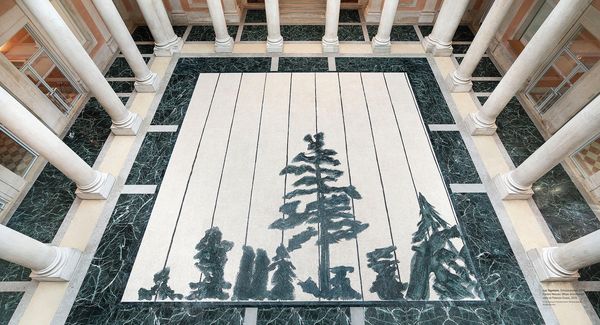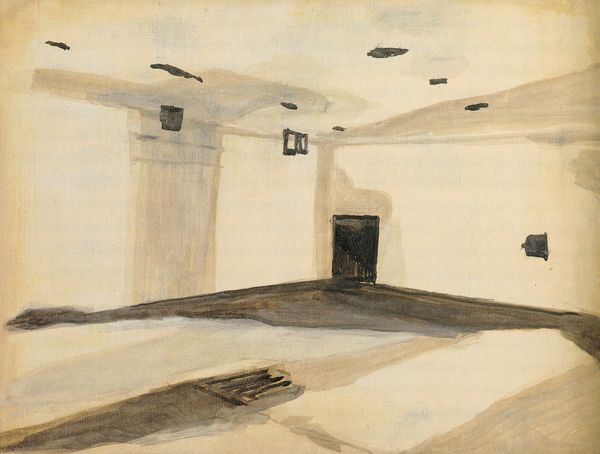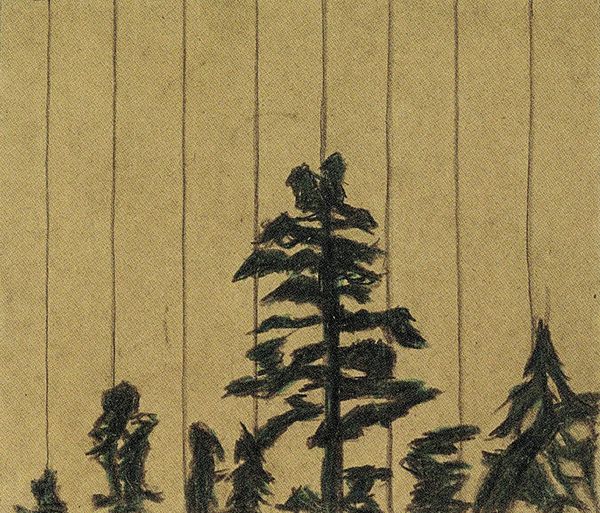Marianne Hoet and Luc Tuymans, 5 June 2019, Antwerp.
Luc Tuymans Schwarzheide, 1986
MARIANNE HOET: Luc, we are happy to be here with you and talk about your work – more specifically about Schwarzheide, 1986. Schwarzheide – essentially a sparse line of pine trees – would appear to be an innocuous subject, a landscape of sorts. However, the trees were planted along the border of a Nazi concentration camp to conceal it from view. The trauma behind the imagery is masked, like the trees masked the camp. What drew you to this scene specifically?
LUC TUYMANS: Schwarzheide is an iconic painting that I painted very early on. It was made after Our New Quarters, as a result of years of reflection on the subject of the Second World War, and the psychological breakdown that it represented for Europe.
Luc Tuymans Our New Quarters, 1986
The painting takes after the drawings that a number of detainees made in concentration camps, and its minimal appearance reflects the atmosphere that all these drawings exuded – often created with a mixture of charcoal and other media that produced a blueish hue. The fact that these drawings conjured one same atmosphere shocked me deeply, because the sketches were made by different individuals. They came from different hands, and yet it seemed like they were created unanimously, conveying the singular image of a void.
I tried to reproduce this impression in Schwarzheide. I took the canvas and put it in the sunlight so that it could yellow naturally, like those drawings did. I painted the pines trees in a very fast move to designate the urgency of the original sketch. This was all important to me because Schwarzheide is about representation and debt, and the agent object had to be incorporated directly in the work. I needed the yellowness and the understatement to be revealed in the painting not as a gimmick, but as a true assessment of reality and time.
Schwarzheide is an image of the naturalization of death, an image that captures violence at its peak through the paradoxical depiction of understatement. In my opinion, true terror is what you don’t show. True terror reverberates from silence.
MH: Your current exhibition at Palazzo Grassi is centred around a monumental mosaic based upon the present work. The title of this exhibition, La Pelle (‘the skin’) takes its name from Curzio Malaparte’s 1943 book describing the distress and turmoil of war. What motivated you to readdress this specific painting now, and why did you engage marble as the medium?
Luc Tuymans, Schwarzheide, 2019, Fantini Mosaici Milan. Installation view at Palazzo Grassi, 2019. © Luc Tuymans, Palazzo Grassi. Photography by Matteo De Fina.
LT: There have been a few ways of exhibiting art at the Palazzo Grassi. I wanted to tweak the monumental approach that many of my predecessors had taken by employing the space differently. I decided to alter the space through the use of an understated, innocent image, to demonstrate its inherent power.
I also wanted to integrate the fabric of the Palazzo Grassi directly in my installation, so I used the same green marble that is embedded within the Palazzo throughout the borders of the work. I wanted to turn the Palazzo’s monumentality inside out – observe people’s behaviour as they walk on the mosaic, thinking perhaps it had always been part of the building throughout its history. With this installation, Schwarzheide is magnified to epic dimensions, and yet its presence is easily concealed.
MH: Your exhibition goes under the skin of the visitor. Are the subjects of your paintings often related to your own emotions or experiences in your own life?
LT: As I draw from existing imagery, it is important for me to know what the source image is about. The starting point is crucial to justify the relevance of my work. So in that sense, how I see and perceive things is perhaps more important than emotion.
MH: Every work stands by itself and has its own title – the title being an important factor to you. However, there is always a dialogue between the works when we see an exhibition by Luc Tuymans. Could you expand on this independent and inter-dependent dynamic?
LT: When a show is installed, it is interesting to see the works interact with one another and create a kind of dialogue or discourse. Crucially, the connections made between paintings will be informed by the raw space that hosts the works, the architecture of that space, and other factors; but nevertheless the connection makes itself organically.
It’s also interesting to see how old and new paintings interact with one another in a place that is old or new, factoring in the idea that oil paintings typically take 25 years to dry up. The aging process forms part of the dialogue.
Luc Tuymans Gaskamer, 1986
Regarding titles, these can be a sheer description of what you see, or something completely different, opening up another layer removed from the painting itself. The title can be an additional image superimposed on the image itself. With Gaskamer, the title makes sense of the painting, which could otherwise be perceived as a vacant cell. Similarly with Schwarzheide, the location of the trees is crucial to understanding their sombre associations.
MH: Luc, you paint in one day. Can you explain us a bit more about the process that precedes the creation of your paintings, as I imagine the conception of your works takes much longer.
LT: With Schwarzheide, everything was orchestrated. There was the research, the drawings… But when it came down to the moment of executing the painting, the process was extremely quick.
Luc Tuymans Study for Schwarzheide, 1985
When painting, you have to transfer the intelligence that you have amassed directly on canvas, put all the things that are in your mind into your hand. I made the process swift but tenacious, as I still had to balance the abstract image of nature that Schwarzheide visually represents, and the mark, the imprint of the source. To me what was important was the intensity of the picture: it had to be realized.
MH: You have often expressed the impact of other Belgian artists on your practice, in particular the work of Jan van Eyck, whom you have lauded as the ‘strongest painter in the Western Hemisphere’. Can you tell us more about what Van Eyck has meant to you and which other artists have influenced your practice?
LT: I was completely blown away by van Eyck’s sense of detail when I first came into contact with his work. I must have been 8 years old; it was the ardent realism of the image that struck me. Mondrian’s diamond-shaped painting in Den Haag, which I saw for the first time at the age of 12, also stayed with me. I remember not comprehending it really, but understanding that within its very small scale, there was something monumental.
The Belgian region is an important source of inspiration for me as it holds significant painterly tradition, but it is also unique in that it has grappled with specific social, political and geographic circumstances, positioning itself in terms of survival. This is why the region has opted for realism more than anything else. People think that Magritte is a surrealist but he is not.
Belgium as a national entity is a tough one to navigate because it is so small. Yet when you think about its artistic accomplishments – its rich Baroque manifestations – especially in comparison to larger countries such as France, Germany, the United States… It is really quite amazing.
MH: The current work, Schwarzheide, was painted when you had just returned to painting from a period when you focused solely on filmmaking. Can you tell us more about how this transition informed your subsequent work?
LT: I stopped painting for five years from 1980 to 1985. Painting had become too existential for me, a suffocating practice that I didn’t have enough distance for. Film allowed a break from that, and taught me to look at things differently. However, I eventually returned to painting.
By having looked through the lens of film, I then began envisaging imagery differently. For example the idea of the close up, or of a disconnected narrative, does not exist in real life, yet it does exist in the filmic image. With film I started looking into the enlargement of an image. Schwarzheide certainly exemplifies this, as the real image exceeds the frame of the painting.

